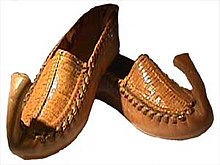Opanke

The Opanke ( Serbo-Croatian opanak / опанак , Macedonian опинок; Bulgarian цървул / опинок, Romanian opincă, Albanian opinga) is a sandal-like , flexible shoe without an insole and heel .
It is made from a single piece of leather , the sole of which is connected to the shaft with a tip that is often bent in the shape of a beak by a braided seam or strap . Originally the Opanke was made from a rectangular piece of raw hide . This manufacturing method makes the shoe extremely flexible and comfortable. The sole adapts to the foot and thus reflects its movement.
It is related to the Bundschuh and is the European form of the moccasin . Occasionally, their shape is picked up in summer shoe fashion.
Origin and Distribution

The opanke is an archetype of the shoe and probably of Celtic origin. In the 19th century , Opanken were still worn in Ireland , Iceland , Italy ( Apulia ), the Faroe Islands , the North Sea and the Basque Country . Footwear was also widespread in Afghanistan , Iran , Turkestan and the Caucasus .

The Opanke is known in three basic forms as the traditional footwear of the rural population of some (south) eastern European peoples. The details of the Opanke could vary between the ethnic groups. In Bosnia and Herzegovina , for example, the Serbs wore tapered opaques, the Bosniaks rounded at the front and the Croatians wore black opaques.
Others
Opanks are occasionally the subject of literary stories (e.g. Opanci dida Vidurine [The Opanks grandfather of Vidurina] by Mile Budak ).
literature
- German Leather Museum (Ed.): Arts and crafts, folklore, ethnology, technical engineering . The museums, 1956, p. 140 ff .
Web links
Individual evidence
- ^ Renate Wolansky: Orthopedic shoe technology for podiatrists . Schattauer Verlag, 2008, ISBN 978-3-7945-2596-6 , pp. 4 .
- ^ Richard Woolnough: The A to Z Book of Menswear . 2008, ISBN 978-1-897403-25-9 , pp. 236 .
- ^ Günter Gall: German Leather Museum: German Shoe Museum: Offenbach . Georg Westermann Verlag, 1981, p. 125 .
- ↑ Hamburg Museum of Ethnology and Prehistory (Ed.): Messages from the Museum of Ethnology in Hamburg . Commissioned by Lucas Gräfe & Sillem, 1987, p. 91 f .
- ^ German Leather Museum (ed.): Arts and crafts, folklore, ethnology, technical technology . The museums, 1956, p. 140 ff .
- ^ Jill Condra (Ed.): Encyclopedia of National Dress: Traditional Clothing Around the World . ABC-CLIO, 2013, ISBN 978-0-313-37637-5 , pp. 87 .